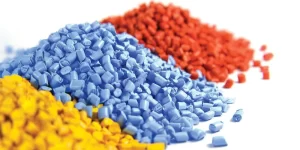
High-quality masterbatch in sabico
Introduction
In the modern plastics and polymer industries, manufacturers continuously seek ways to enhance product quality while minimizing production costs. One of the most effective solutions is the use of masterbatch — a highly concentrated blend of pigments or additives encapsulated into a carrier resin. Masterbatch enables efficient and uniform coloration and performance enhancement of plastic products, making it indispensable across various sectors such as packaging, automotive, agriculture, medical devices, and consumer goods.
High-quality masterbatch in sabico
What is Masterbatch?
Masterbatch is a solid or semi-solid additive formulation composed of:
Carrier resin (base polymer)
Pigments or functional additives
Dispersing agents or compatibilizers
It is typically added to raw polymer materials during processing (in extrusion, injection molding, blow molding, etc.) to impart specific characteristics such as color, UV resistance, anti-static properties, or flame retardancy.
This method provides better consistency, improved process control, and is considered more cost-effective than directly adding raw pigments or additives.
High-quality masterbatch in sabico
A Brief History of Masterbatch
The use of additives in plastics emerged around the 1950s. Early attempts at direct pigment addition led to inconsistent coloring, contamination, and inefficiencies. The masterbatch concept was developed as a standardized, cleaner, and more efficient alternative. Over time, it evolved into a critical component of polymer engineering, enabling advanced product performance with precision.
Main Types of Masterbatch
1. Color Masterbatch
Color masterbatch contains a high concentration of pigments or dyes and is designed to impart uniform color to plastic products. It’s used in:
Packaging films
Automotive parts
Toys and housewares
Consumer electronics
Color masterbatches offer advantages such as:
Improved color consistency
Custom shade development
Clean handling and minimal dust
Reproducibility in large-scale production
High-quality masterbatch in sabico
2. Additive Masterbatch
These masterbatches enhance physical or chemical properties of plastic products and include:
UV stabilizers: For outdoor exposure protection
Anti-static agents: To reduce dust attraction
Anti-bacterial agents: Common in medical and food-grade packaging
Anti-fog agents: Used in greenhouse films and food wraps
Flame retardants: Used in electrical components and automotive interiors
3. Filler Masterbatch
Filler masterbatches contain materials such as calcium carbonate or talc to:
Reduce material costs
Improve rigidity and dimensional stability
Minimize shrinkage
Enhance processability
4. Clarifying Masterbatch
This type is used to improve the clarity, transparency, and gloss of finished products — ideal for:
Food containers
Medical packaging
Cosmetic bottles
High-quality masterbatch in sabico
Core Components of Masterbatch
1. Carrier Resin
The carrier polymer must be compatible with the end-use resin. Common carriers include:
Polyethylene (PE)
Polypropylene (PP)
Polystyrene (PS)
Acrylonitrile Butadiene Styrene (ABS)
The right carrier ensures uniform dispersion and process stability.
2. Pigments or Additives
Pigments may be organic (bright colors, lower thermal resistance) or inorganic (more stable, durable). Functional additives provide the desired property, such as:
UV resistance
Flame retardancy
Antioxidants
Slip or anti-block agents
3. Compatibilizer/Dispersing Agent
This helps the additives or pigments mix effectively with the base polymer, improving uniformity and preventing separation during processing.
High-quality masterbatch in sabico
Masterbatch Manufacturing Process
Raw material selection
Mixing pigments/additives with carrier resin
Extrusion and melt blending
Cooling and granulation
Packaging and quality control
Quality checks at each step ensure optimal dispersion, color stability, and performance.
Characteristics of High-Quality Masterbatch
A reliable masterbatch should offer:
Uniform dispersion of pigments/additives
Stable color under thermal and UV conditions
No visible specks or contamination
Compatibility with target polymers
Proper melt flow index
No interference with manufacturing processes
Long-term durability of the intended functionality
High-quality masterbatch in sabico
Benefits of Using Masterbatch vs. Direct Additive Application
| Feature | Direct Addition | Masterbatch |
|---|---|---|
| Control over dosage | Poor | Excellent |
| Color consistency | Inconsistent | Uniform |
| Clean handling | Dusty, messy | Clean, granulated |
| Process optimization | Hard to adjust | Easy to calibrate |
| Equipment contamination | High | Low |
Difference Between Masterbatch and Polymer Compound
Although both are used in plastics, their roles differ:
Masterbatch is a concentrated mix added during processing to color or enhance properties.
Polymer compound is a ready-to-use blend of polymer and all necessary additives for direct shaping or molding.
Compounds are typically used when the final product requires very specific mechanical or thermal properties.
High-quality masterbatch in sabico
Applications Across Industries
| Industry | Masterbatch Use |
|---|---|
| Packaging | Coloring films, UV protection, anti-fogging |
| Automotive | Interior parts, cable coatings, UV resistance |
| Agriculture | Mulch films, greenhouse covers, anti-drip coatings |
| Medical | Antibacterial syringes, clear tubing |
| Construction | Flame retardant panels, weather-resistant pipes |
Key Considerations When Buying Masterbatch
Compatibility with your polymer
Desired color strength or property enhancement
Thermal stability during processing
Supplier reliability and technical support
Certifications or compliance with industry standards
Custom formulation options
Working with a reputable supplier can save time, reduce production issues, and ensure consistent product quality.
Conclusion
Masterbatch has become an essential element of plastic manufacturing, offering superior performance, easy handling, and cost-effective customization. Whether used for coloring, UV protection, antimicrobial properties, or structural enhancement, selecting the right type and formulation is critical for achieving the desired product quality. With proper application and sourcing, masterbatch can be a powerful tool for innovation, sustainability, and competitiveness in the plastics industry.